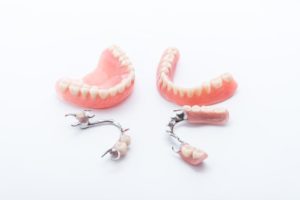Dentures

Have questions about dentures and restorative dentistry? Our dentists took some time to share information and answer common patient questions to help educate about what dentures are and the role that they play in oral health. View the table of contents below to learn more or find your question and get an answer from one of our dentists!

The following content was provided by Dr. Don Bailey, DDS, and has been medically reviewed for accuracy. Some relevant links have been added to audio transcripts to provide resources for additional information.
Table of Contents:
Click a question below to be taken directly to that answer.
What are dentures? What are they made of?
Answer provided by Dr. Don Bailey. Transcript included below.
Dr. Don Bailey:
Dentures are a way of replacing missing teeth by having something that’s removable instead of fixed like a bridge or an implant. Partial dentures replace some teeth and full dentures would replace all the teeth in an arch. I think everyone’s kind of seeing like a little cartoon drawing of what they look like. For the most part, they have an acrylic base with acrylic teeth embedded in the base to look like gums and teeth. It stays in place for the most part by suctioning against the gum tissue butting against the ridge.
Partial dentures can be made of just all acrylic, but they’ll generally have some amount of metal in there either through little wire clasps like an orthodontic retainer will have, or they’ll have a metal frame to give them strength and also to allow them to be really thin. Acrylic is only so strong, so you have to make it have a couple of millimeters of thickness to really support biting forces. But the metal partials can be very thin, less than a millimeter thick, and hold up to anything up to dropping them and stepping on them. There are some flexible materials that exist that are either nylon based or carbon fiber based. The nice thing about those is they’re very lightweight, but they still don’t quite have the ability to make full dentures out of them. So for the most part, full dentures are made of just normal pink acrylic.
Actually sometimes if you were to see dentures being made it would remind you some of the equipment that’s being used for polishing and shaping are what’s being used in salons to make acrylic nails. There’s actually a lot of similar tools for contouring, shaping, polishing and things like that.
How are dentures made?
Answer provided by Dr. Don Bailey. Transcript included below.
Dr. Don Bailey:
For full dentures that are replacing all the missing teeth, there are two techniques that can be made to make them. The traditional method is to take the teeth out and heal anywhere from one to four weeks or longer before the denture’s made. Most people aren’t able to go for a very long time without teeth, either because of just the reality of their life, they may have a job where they don’t feel comfortable working without teeth or people worry about being able to eat certain things without teeth.
You can start almost right away, but what you’re going to end up with is a denture that doesn’t fit very well because the gum and the gum line, the bone they’re going to change shape after the teeth come out. First, they’re going to heal, but then they’re going to remodel. If there’s no teeth there, our body doesn’t need quite so much bone. So I think people who start making dentures too quickly after the teeth come out, will notice that they lose their fit fairly quickly.
What we normally find is people that are waiting four to six weeks or even slightly longer, will get a more predictable fit. It’s just sometimes very difficult for someone to wait that long. But when you make a denture with the traditional method, you’re waiting until after the teeth have come out and the ridge has healed, and then you’re beginning the molding process then, and you go through several try-in visits where you progressively try-in first just the bite, what are the dimensions of the denture. And then you try-in what the teeth look like and what they feel like and what the bite feels like, and then the denture’s made.
So when you’re doing all of those steps to get the absolute best fitting denture that you can, that takes about another four weeks to do on top of the healing period. So with the traditional method of making dentures, you get the best fitting denture that you can get because you’re taking the molds that determine how the denture fits, you’re taking them after healing has occurred. And you have a chance to try every step of the process in, so you’re not going to get a denture that’s so short you can’t see it, so it looks like you have no teeth at all. And you’re not going to get a denture that’s got teeth that look too big or wrong color, or that are tilted at an angle. You’re going to have a chance to try it in and make sure that everything sort of passes your muster before it gets processed and finished. But you’re going to go for weeks or months to have it finished.
The other method for making a denture is what’s called the immediate method and some, or all of the steps of making the denture are actually done before the teeth come out. What’s happening then is the same day or very shortly after the teeth come out, the actual denture’s going in the mouth. That has a very obvious advantage of you come with teeth and leave with teeth sort of thing, so there’s very little time that you go without having teeth. But the drawback is, is all of the things that you get as a benefit from doing the traditional method of making a denture, you lose with the immediate. You never have a chance to try-in all of the teeth to make sure that the bite is correct, or that the aesthetics, the color, the angulations and things like that, you never get a chance to try that in completely.
Some people are already missing some teeth, so you can get a sort of an idea, but you still can’t see the whole thing. And also the denture is made on a ridge that hasn’t healed, so the ridge and the gum and bone are going to shrink so the denture will lose its fit when you do an immediate method. The other thing too, is the fit is not very tight to start with because the lab is having to estimate where they think the gum line will be after the teeth come out. So they tend to make these dentures a little extra loose so that they don’t interfere with the ridge while it’s healing, which usually means that we have to add a temporary material so that they even fit snugly at all.
With the traditional denture, you get great predictable fit aesthetics, but you have to go for a period of time without teeth. With the immediate method, you go straight from your natural teeth to the other teeth, but it’s not as predictable because the fit is probably going to be looser and will definitely loosen even more during that first healing period, and you never get a chance to really try-in everything.
There are a lot of people though, who do like their immediate dentures. I think the more teeth that someone is already missing when the immediate denture’s made, the more predictable that is. But you generally have to realign an immediate denture with acrylic somewhere in the first six months after they’re made just so they’re not so loose on the gums.
You can combine those two methods and you can make an immediate set of dentures that someone will wear temporarily and then make them a final set afterwards. But that kind of gets a little more complicated and costly doing it that way. Both methods work, they just have their pros and cons.
How long do you have to wait to get dentures after your teeth are pulled?
Answer provided by Dr. Don Bailey. Transcript included below.
Dr. Don Bailey:
That’s where if you want the most predictable outcome, then you want to wait about four weeks after the teeth come out. It’s hard to say the best denture because you can get a really good denture doing the immediate method where the denture is made the same day the teeth come out, but it’s a lot harder to get a good denture made that way than if you wait several weeks and then start. Because the molding is going to be made of the fully healed gumline, so the lab knows exactly what the gums are going to look like, so they know exactly how to fit the denture. And then you’re going to get a chance to do the different try-ins so that we can make sure that the denture has the right height, depth, and width, and that the teeth have the right alignment and right color and right shape. Generally speaking, four weeks is about the best … four to six weeks to start. Practically speaking, I think three to four weeks is right there.
Dentures with dental implants
Answer provided by Dr. Don Bailey. Transcript included below.
Dr. Don Bailey:
Dentures can be combined with implants, so a lot of people are thinking about implants replacing teeth. But you can do what are called overdentures, where you can have a few implants placed and then dentures will actually snap onto those implants with the same type of snaps that you would use to button up a jacket. When that’s done, the denture will stay in all day without any adhesive and will stay in without having the cover as much of the inside of the mouth.
When someone has a denture made for their upper arch, it has to cover their entire pallet to get suction. But if you use a few implants, so two to four implants and snap the denture in, your pallet will be open so you can talk like normal, taste like normal, and everything else. With the lower, a lot of people struggle with their lower denture moving some on them and that’s because with the upper, you have a roof of your mouth that you can suction against, but the floor of your mouth is a muscle so you can’t suction against a muscle that moves. The lower ones tend to move and want to come out and do things like that, but with putting a couple implants in a lower one can snap in and stay in just as well as an upper.
I think too often people aren’t really thinking about combining them together, but we have some of our best success with dentures with these overdentures that are snapping in implants for a … Not only do they stay in better, but you can chew things that you otherwise wouldn’t be able to chew because there’s more still. They’re not sliding and moving around as much, so some people find it easier to be able to eat some of the meats that they like and things like that if they have implants for support.
There are even more sort of hybrid type of things where you combine a denture on a bridge type frame to attach with implants, but that’s a lot more complicated type of thing. I think the good thing with these overdentures is they’re just as easy to make as normal dentures are. We just attach them to implants at the end of the process with little snapping components.

